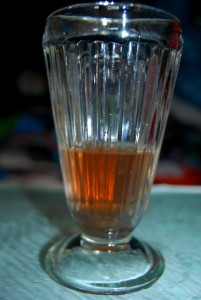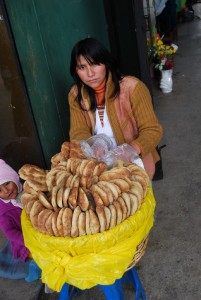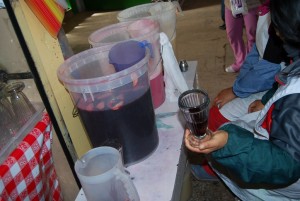Two Words that Make Cuzco

Cuzco not only has Inca walls and an unusual collection of Spanish colonial buildings, it has many ways of being and acting that make it distinctive. To be sure its elites have been trying to capitalize on its past and present by trying to make it ever more Inca; the fiberglass statue of the Inca Pachacutec posed atop the fountain in the main square witnesses to this romance with an idealized past. But as you walk its streets or go to the market you will run into customs that, without comment, reach deep into the past and give Cuzco its being.
Perhaps the simplest of these, and one that is generally not much discussed, takes place whenever one buys emolientes or chicha, as well as much food. A simple four letter word describes it and that word has no equivalent in Spanish, though it is one of two Quechua words to make it into English.
It is the “yapa” (called lagniappe in Louisiana English–the other Quechua word is “jerky” from “charqui”.)

Though simple, the word comes from a verb that is quite important. Furthermore, this word is one of the basic words that is shared with the neighboring Aymara language. “Yapa” describes increase or growth. As such it stands between the hopes of the buyer and merchant.
Another word that is common in Cuzco–and related to “yapa” — is “casera.” One can go to markets and street food stands throughout Latin America, but one only hears these words, “casera” and “yapa” in those lands that once were part of the Inca Empire. They truly set off a cultural area with Cuzco at its core.

Market women will call out to passersby: “Casero, I have good potatoes. They just arrived from … Buy some from me.” And, if interested, the passerby will say “ok Casera. How much are they?”

While the relationship of buying and selling is at least as old as markets, if not older, with all the potential of haggling over price, the word “casero” to describe the relationship built by the two is different.
Often when one buys, once the money has changed hands the relationship is completed. It is over. In many places, while haggling, people will work to pretend to be good friends, as if they were building a relationship through the exchange. But even so, once the money has changed hands, it is likely the relationship is finished until the buyer returns to the market and the same stall.
Having a name for the relationship, “casero” fixes the interaction as something potentially permanent, like the relationship between “compadres” the parents and godparents of a child, or like that of “amigos”, friends. The word builds an equality in which both sides hope for something and possibly find it in the interaction.
As a result, there is something charming about the term and its use. By saying “casera” or even better “caserita”, with the warmth of the diminutive, one fits into local culture and hints that the purchase may only be the first of many that can last over a period of time.

In fact, “caseras” take care of their “caseros” by giving them extra special goods, better than the norm, or looking out for their particular needs. And the buyer “casero” returns to the same stall, hooked by the benefits, as well as the charm and conversation–the warmth of their “casera.”
The “yapa” plays an important role here. It is that little bit extra which one gives, once the purchase is agreed on, that demonstrates the specialness of the relationship, whether in reality or only in potential.

Like all things, the “yapa” can become something mechanical. One might stop at a cart overflowing with oranges and long strands of peels, where a woman presses out glass after grass of fresh-squeezed orange juice. Besides being absolutely delicious, the juice increases once one drinks it down, when the woman or her helper takes the returned glass and fills it almost full again for you.
You don’t have to say anything. It happens automatically.
But even here is the seed of growth. With a little here and a little there, the seller can hope to build an ongoing relationship. At the same time, the buyer can hope for more by building the tie both through using the word “casera,” which comes with a “yapa” along with pleasantries.
In any case, the “yapa” and “casera” as relationships are a big part of making Cuzco the city it is. Though swamped by tourists and services for them from international culture, the city continues to have its own heart; it just is itself.




